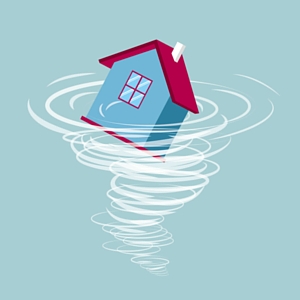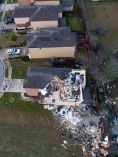The Safest Place to Be During a Tornado

People who live in coastal areas have to prepare for hurricanes each year from June through the end of November. They make sure they have hurricane shutters at the ready, and are often given enough notice to stock up on bottled water and other supplies. But if you live in Tornado Alley—an area of the Midwest that attracts more tornadoes each spring than any other part of the country—you often have very little time to retreat before a tornado could bear down on you. You need to have a plan so you and your family know exactly where to go when the time comes.
To prepare for tornado season, many Midwesterners try to live in homes that have basements. Ideally you would find a house with a safe room in the basement. However, high water tables and soil of the wrong consistency often means houses have to be built without basements in Tornado Alley. In these areas, people are looking for houses with built-in safe rooms.
The Case for Basements
According to the National Oceanic and Atmospheric Administration, the safest place during a tornado is completely underground, as in a basement or a storm cellar. If the basement has windows though, stay away from them. During a tornado, high winds pick up debris and throw it through windows. The downside to sheltering in a basement is the possibility of injury or sometimes even death from parts of the rest of the rest of the house collapsing. It's still a better bet, however, than staying upstairs.
The Case for Safe Rooms
If your house doesn't have a basement, the next best thing is a safe room. This is a room that's built with reinforcements specifically designed to withstand tornado force winds. If you're building a house without a basement, you could have a bathroom or walk-in closet built with these reinforcements, but to be sure they are safe, they should be constructed according to guidelines set by the Federal Emergency Management Agency. You could also retrofit a room in your home to be a safe room.
Above ground safe rooms that are built in to your house are a good option for those who cannot easily go up and down stairs. Above-ground safe rooms that are not built in to your house can provide adequate protection, but they are costly to construct and could be an eyesore. In addition, you may only have a short timeframe to get to it. This is an important consideration if someone in your family has trouble moving fast or if you are trying to make sure kids and pets get there quickly. Separate below-ground shelters are also a good option, but you run the risk of debris weighing the door down so much that you can't get out.
There are pros and cons to each option. If you are considering retrofitting a room in your house to be a safe room or you are considering building one, find a company that specializes in this and ask them which option is best for your area.
Wherever you decide to take shelter, bring pillows and blankets to help shield yourself from any flying debris or anything that could come crashing down on you. Also wear shoes so that you don't cut your feet on debris after the tornado passes. And whatever your tornado safety options are, don't ignore the warnings! Most tornadoes only last a few minutes. Being in a safe place for that short amount of time is surely worth it, no matter what kind of disruption it causes in your day.
-
Make a Plan
 What to Do
What to DoKnowing what to do before a tornado warning is in your area is key to literal survival. There’s only so much you can do to protect your home, but here’s how to protect yourself.
-
Make a Kit
 What to Take
What to TakeNow that you know where to go to seek safety, here are some things you should have ready to grab if you have to go to your safe spot. Don’t sleep on these tips!
-
Make a Claim
 What to Expect
What to ExpectWe hope the worst doesn’t happen, but if it does, we may send additional claims teams to your area. Here’s what to expect about the claims process.
